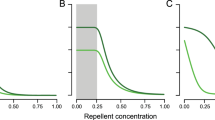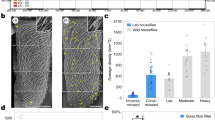Abstract
The evaluation of behavioral responses of an organism to a particular stimulus normally implies the design of a bioassay. Measurements of the response in a number of replicates are necessary to perform inferential statistics and therefore accept or reject a hypothesis about the effect of the stimulus on the behavior of the organism under study. In the present article, we address the importance of pseudoreplication in studies of chemical ecology, particularly in laboratory experiments on olfactory responses of insects to semiochemicals in olfactometers and wind tunnels. Pseudoreplication may be caused by lack of independence in the stimulus or the experimental device, the reutilization of test insects, or the use of groups of test insects, without adequate statistical analysis addressing such dependency. Each and all of the cases reviewed (N = 105) lacked information in at least one of the factors listed above; hence no cases could be said with certainty to be free of pseudoreplication. Forty-nine cases (46.7%) contained explicit information revealing that pseudoreplication existed in terms of one or more of the criteria listed above; in only three of these cases did the authors address statistically the stated dependence of the samples. Pseudoreplication due to different factors ranged from 2% to 30% of the cases, with an average of 13%. The most frequent sources of pseudoreplication were the reuse of the device and the use of groups of test insects. The analysis showed the low importance given to obtaining independent replicates in bioassays involving olfactometric responses of insects to semiochemicals.
Similar content being viewed by others
REFERENCES
Giles, D. K., Heinz, K. M., and Parrella, M. P. 1996. Quantitative assessment of insect olfactometer performance by experimental flow analysis. Biol. Control 7:44–47.
Heffner, R. A., Butler, M. J., IV, and Reilly, C. K. 1996. Pseudoreplication revisited. Ecology 77:2558–2562.
Hulbert, S. H. 1984. Pseudoreplication and the design of ecological field experiments. Ecol. Monogr. 54:187–211.
Hulbert, S. H., and White, M. D. 1993. Experiments with freshwater invertebrate zooplanktivores: quality of statistical analyses. Bull. Mar. Sci. 53:128–153.
Krebs, C. H. 1989. Ecological Methodology. Harper Collins, New York, 654 pp.
Searcy, W. A. 1989. Pseudoreplication, external validity and the design of playback experiments. Anim. Behav. 38:715–717.
Stewart-Oaten, A., and Murdoch, W. W. 1986. Environmental impact assessment: “pseudoreplication” in time. Ecology 67:929–940.
Wiens, J. A., and Parker, K. R. 1995. Analyzing the effects of accidental environmental impacts: Approaches and assumptions. Ecol. Appl. 5:1069–1083.
Author information
Authors and Affiliations
Rights and permissions
About this article
Cite this article
Ramírez, C.C., Fuentes-Contreras, E., Rodríguez, L.C. et al. Pseudoreplication and Its Frequency in Olfactometric Laboratory Studies. J Chem Ecol 26, 1423–1431 (2000). https://doi.org/10.1023/A:1005583624795
Issue Date:
DOI: https://doi.org/10.1023/A:1005583624795




